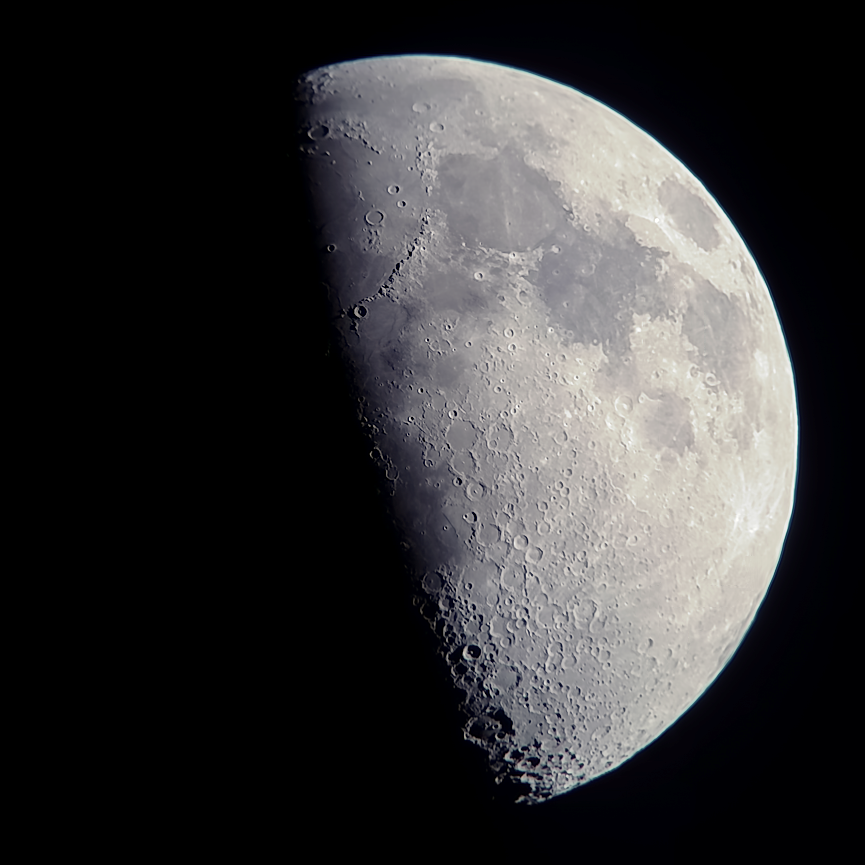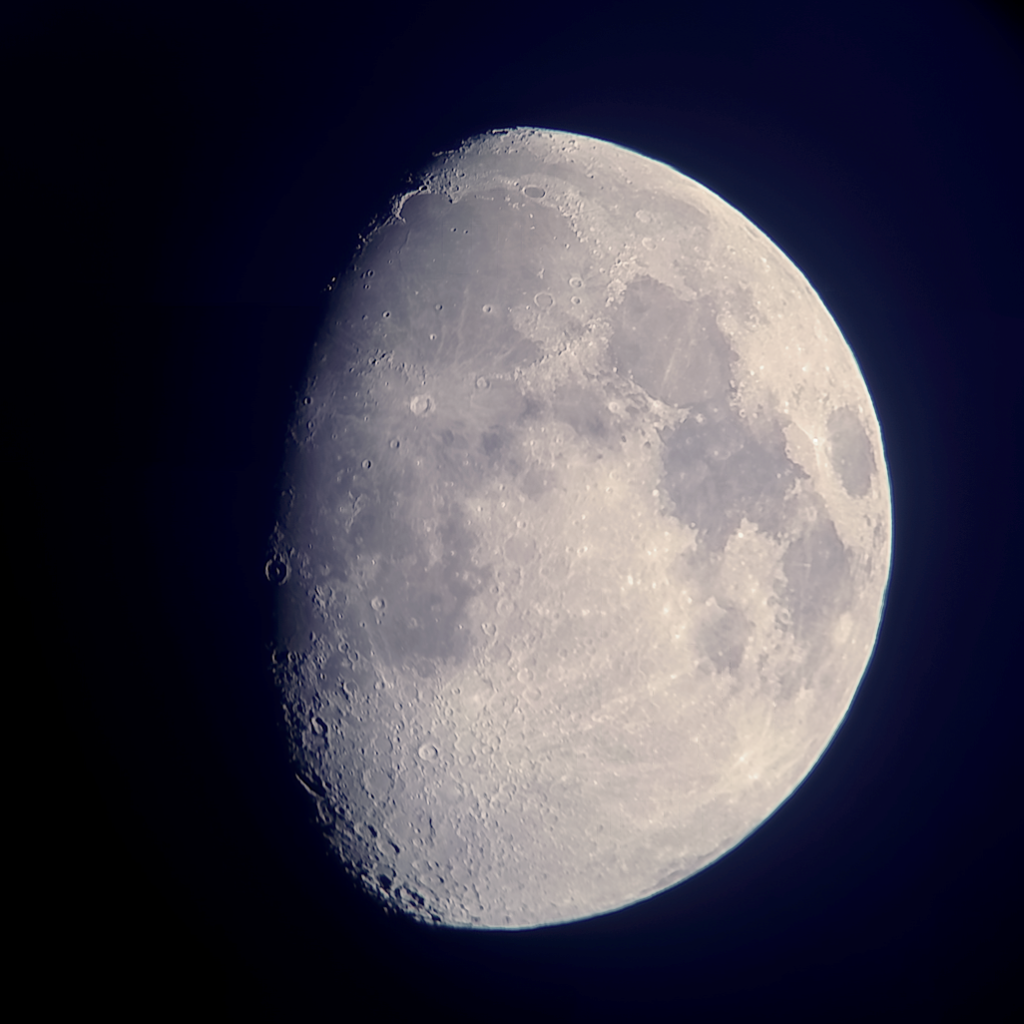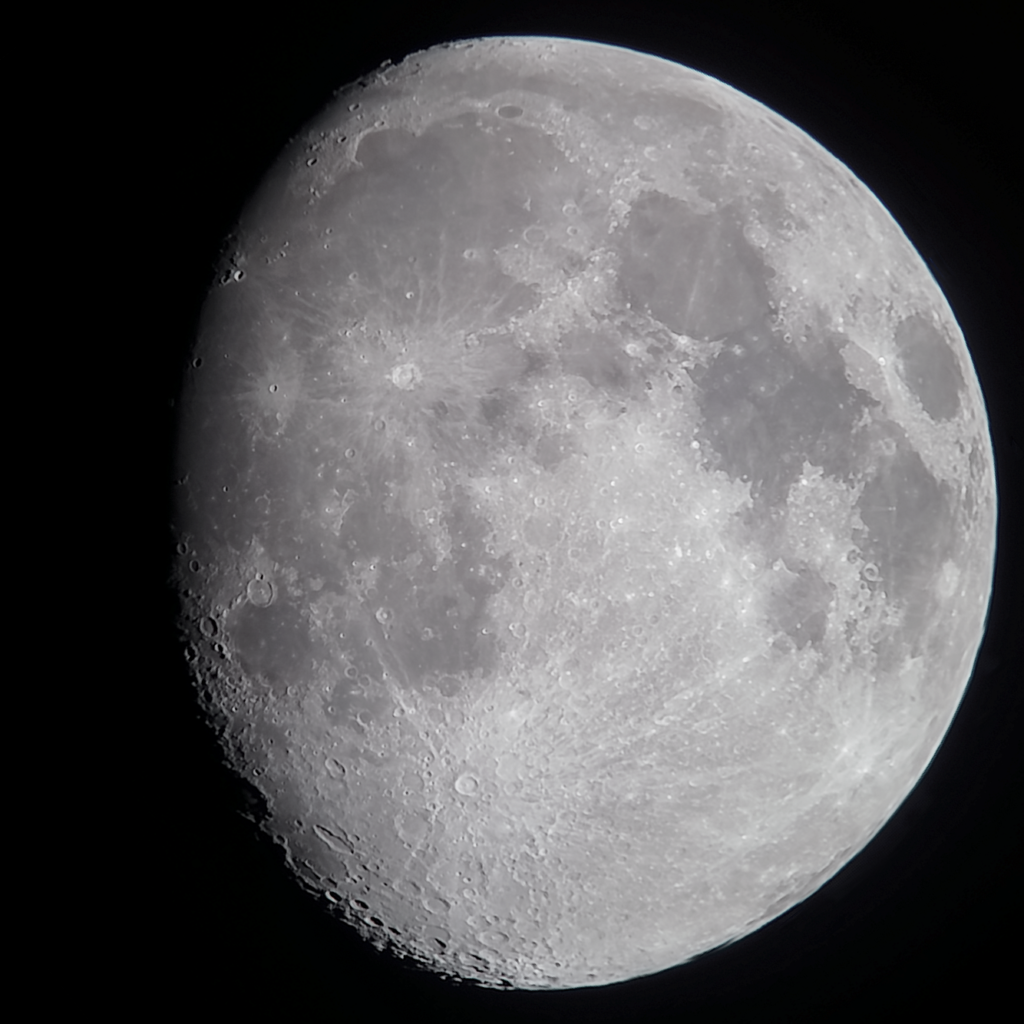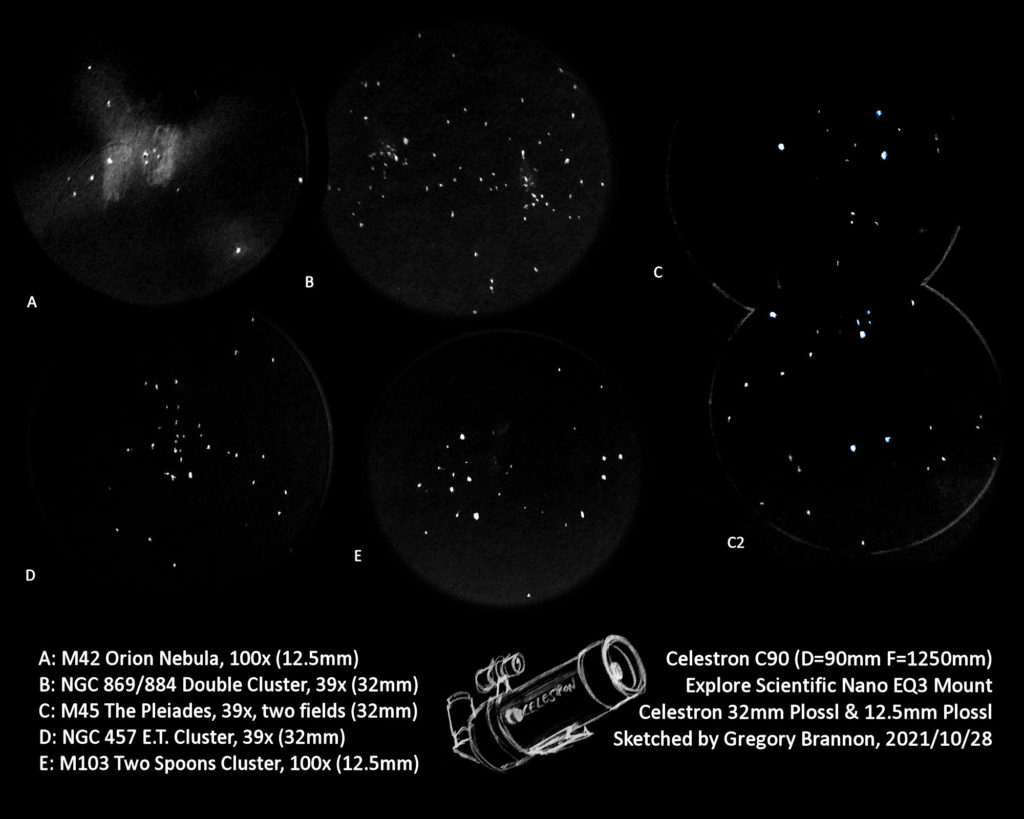The C90’s Optics
The Celestron C90 is a Gregory-Maksutov-Cassegrain Telescope. In a Cassegrain, a short-focus concave primary mirror focuses light toward a convex secondary mirror, which folds the light backward through the rear of the telescope, as well as vastly increasing the overall focal length. A true Cassegrain uses a parabolic primary and a hyperbolic secondary, but these are expensive figures to polish into a mirror. In SCTs and Maks, a corrector lens element is added at the front to correct for spherical aberration in the spherical primary mirror. SCTs use a thin, higher order curve, while Maksutovs use a thick, spherical meniscus lens. In a Gregory-Maksutov, the secondary mirror is a metallized spot on the corrector lens. Gregory Maks thus have entirely spherical surfaces, making them much cheaper to manufacture, but they can almost totally correct for spherical aberration.
The C90 has an aperture of 90mm (3.5”) and a focal length of 1250mm (f/14). This focal length is just two inches longer than a typical ground-standing Dobsonian reflector, so images generally feel a lot like they do in a Dob, just dimmer. (A 6” Dobsonian has roughly three times the light grasp).
I have had two Celestron C90s. The first one had to be sent back to Celestron due to poor optics. I received a replacement with somewhat better optics. The first C90’s stars had two bright rings around them, a sign of fairly severe higher order spherical aberration. The result was that, although the Moon and daytime objects looked pretty good, observing the planets at high powers was very disappointing. I had compared the C90 with my Orion Short-Tube 80 side-by-side and was shocked to find that, despite having a smaller aperture and being a short-focus achromat with some false color, the ST80’s planetary images looked brighter, more contrasted, and higher resolution. The cheaper, smaller refractor wiped the floor with this first C90.
My second C90 has much better optics. The higher-order spherical aberration is still present, but much subtler. Planetary images are much better, but they are still fairly blurry on very small scales. I was unable to get more resolving power out of the telescope at 178x (just shy of the typical maximum power for a 90mm telescope) than at 125x, and though the view at 125x showed slightly more detail, it was noticeably slightly fuzzy. The 100x view (with a 12.5mm Plossl) was more pleasant, but pretty small. Contrast isn’t very good on Jupiter’s cloud bands or the Cassini division in Saturn’s rings. The view is acceptable, given the limitations of the aperture, but I still felt like it wasn’t giving me all that a 90mm telescope should have.
My speculation is that due to the optical design of a Maksutov involving higher-order spherical aberration, the same ¼ wavelength error that would normally be acceptable in a telescope is actually worse for the very tiny scales where you care about such things as fine planetary details. The same amount of error that would be acceptable in a Newtonian or a Refractor shows up differently in the diffraction images of a Maksutov, specifically in the form of throwing up two bright rings outside of the blurred point-source circle of a star. So a perfect Maksutov can be as good as a perfect Newtonian, but an acceptable Newtonian is better than an acceptable Maksutov.
The C90’s Construction
The Celestron C90 is a sturdy telescope, probably more so than the other branded Synta 90mm Maks. It’s generally a little more rugged. It weighs 4.62 lbs, compared to the 3.7 lbs of the Orion Apex 90. There are two heavy metal pieces on the front and back. The front holds the maksutov-plate and the back holds the primary mirror cell. The C90 is focused like a typical amateur SCT, with a focuser knob on the back which ends up pushing the primary mirror forwards and backwards. This actually slightly adjusts the overall focal length of the telescope. This setup is much more versatile than a focuser drawtube, which moves in and out, because it allows you to focus on nearby targets as close as 15 feet away. However, it does take a long time and many turns of the knob to adjust focus from infinity to nearby. Image shift is a potential issue in any telescope that focuses by moving the mirror spacing. My first C90 had no image shift. The second has some, but it’s not terrible–objects still generally stay in the field of view, but it does make it harder to precisely get the focus you want.

The telescope is painted black. The main tube is glossy black with gold flecks, similar to the “Black Diamond” livery used by Skywatcher telescopes, and the Celestron C5 SCT spotting scope. It looks nice!
There are six primary mirror collimation screws on the back piece, accessible with an allen key. Both of my C90s arrived in good collimation, so I had no need to mess with them.
The back of the telescope has a built-in T-adapter for cameras, with a removable 1.25” visual back screwed on. It is not possible to use 2” eyepieces with the C90.
On the top of the tube is a Synta-style finder shoe. On the bottom is a short Vixen-style dovetail for use in astronomy mounts, with three divots for a mounting screw to dig into, as well as a couple ¼ 20 mounting holes for photographic tripods.
C90 Accessories
The basic C90 is packaged as a portable spotting scope and includes some nice accessories. The telescope comes with a nice nylon backpack. It’s a little small even with the arm straps fully extended, but then, I’m pretty big. I can still fit the backpack on. The C90 fits inside it with room to spare for the other accessories.
The telescope comes with a 45-degree erecting prism diagonal, a 32mm Plossl eyepiece yielding 39x magnification, and a 5×25 finderscope.
32mm Plossl: This is the only eyepiece you get. It’s a nice one. It has a super long eye relief, so it’s easy to see the full field of view without pressing your eye to the eyepiece. A 32mm Plossl gives the widest possible field of view for a 1.25” focuser, so they’ve given you the best shot at finding what you’re looking for right out of the box. 39x is enough to see cloud bands on Jupiter and the rings of Saturn, and the moons of both, so even without an additional eyepiece, there’s still some interesting planetary astronomy to do.
45-degree Erecting Prism Diagonal: A diagonal is a necessity in a telescope where the eyepiece is in the back, as it provides a more comfortable viewing angle than if you had to look straight through. A 45-degree prism works fine if you’re observing objects near the horizon (typical daytime use), but it is nearly worthless when observing at night! When pointed above 45 degrees, you have to look up into the eyepiece, which puts a strain on your neck and may not even be possible, depending upon how you’ve mounted the telescope. The diagonal is crying out for replacement with a 90-degree mirror diagonal. The prism also introduces a small amount of false color fringing and reduces image quality, but for daytime use it’s almost unnoticeable and for night time use it’s still pretty subtle.
5×25 Finderscope: One of my friends, who had owned a C90 before, complained about how terrible the finder was. I actually thought it was pretty good. It’s not the same as the 5×20 (really more like a 5×10) plastic toy finder sold with many cheap beginner telescopes, it’s a functional small telescope with a decently wide field of view, a sharp, realistic image, and a usable focus knob. It is clearly intended for daytime use, where the dim images aren’t a real problem, but there are a few deep-sky-objects and pointer stars I could see in the
My first Celestron C90 came from Optics Planet, and included a couple extras: a big tripod with its own carry bag, and a 12.5mm Plossl. When I purchased mine, the Optics Planet bundle was the cheapest way to get a C90. However, it was in this bundle that I got the C90 with the flawed optics. I have no idea if this could be correlated.
12.5mm Plossl: This eyepiece is pretty nice, and it provides 100x magnification. It’s sharp and gives a decent field of view. Eye relief is a little narrow though. For planetary observation, 100x is much more suitable than 39x.
Celestron Photographic & Video Tripod: This is a terrible tripod. It is barely adequate for a 50mm or 70mm short-tube refractor at low or medium power. Or maybe a point-and-shoot camera. Its motions are stiff, it often feels like I’m twisting the flimsy plastic it’s made of, and it wobbles so much it’s absurd. For terrestrial use, this would be frustrating enough, but in astronomy, where the tripod must be aimed higher than normal, it’s almost impossible to use. I tried using it for astronomy with the C90 on one occasion. I could not even manage to get the moon entirely in the field of view at 39x. The tripod is a joke. When it comes to mounting the C90, you’re on your own.
Mounting the Celestron C90
The C90 is sold in a package with just the Optical Tube Assembly and a few accessories. It is intended to be mounted with a separate photographic tripod. But it also uses a Vixen-style dovetail, which allows it to be mounted on many astronomical telescope mounts.
The C90 may be a lightweight telescope, but you do have to think carefully about how to mount it. The mount must not be flimsy–with such a long focal length boxing you into higher magnifications, the telescope is very sensitive to wobbles and vibrations. A mount with slow motion controls would come very much in handy.
The C90 could be mounted on a computerized mount, but this would be overkill–anything worth looking at in a C90 is something you can find yourself.
A photographic tripod can be used, but it must be sturdy, capable of supporting a payload of perhaps 10 lbs. or more. The C90 is only 4.62 lbs, but it requires an especially sturdy tripod and mount head to support it without wobbling. In addition, the tripod must be capable of being balanced in the altitude axis. A typical photo tripod puts the altitude axis well below the center of mass, so that when you aim high, the telescope becomes very unbalanced. This is a nightmare when you’re trying to find objects. My Bogen 3030 three-way pan & tilt head can be manipulated so the altitude axis points straight up and the intermediate axis becomes the new altitude axis. This makes the telescope balanced as it points high up.
Dedicated astronomy mounts also exist for both altitude-azimuthal and equatorial types of motion. Both mount types can typically be balanced for smooth and consistent motions in both directions. Altaz mounts are usually side-mounted. This will put the finderscope on the bottom of the scope, unfortunately, but it is still somewhat usable. I have made use of a Vixen Porta II Altaz mount and an Explore Scientific EXOS Nano EQ3 mount. Both have been acceptably smooth and sturdy, but they still have some amount of vibration and wobbly visible through the sensitive C90’s images.
I have mostly used the Nano EQ3 mount with the C90. The slow motion controls and the ability to manually track come in handy, and the finderscope is more usable. It’s also a pretty good deal–probably the only affordable EQ mount that is really worth using with a telescope is as sensitive to vibration as the C90.
Note though that a mount for the C90 can be a pretty expensive thing to spend money on, especially the dedicated astronomy mount options. Thus, I put the C90 in the category of being mostly useful if you already have a good photo tripod.
What you can see with a Celestron C90
The Moon: If there’s one thing the Celestron C90 can do very well, it is the Moon. Some of my best (though still very amateurish) photos of the moon have come from the C90. Its long focal ratio means that cheap eyepieces do not generate many distortions, so as the Moon drifts through the field of view, it does not distort too much.



The Moon looks great in the C90, and at a range of powers from 39x up to 125x, it looks very nice. (I could not stack videos taken at higher powers due to the limitations of eyepiece projection with smartphone cameras–a DSLR or planetary imager might have been a better choice–but a tracking mount would also have been needed.)
The Moon is rewarding in almost any telescope, so this shouldn’t be a surprise. The other thing you use a long-focus telescope for is the planets. So how do they stack up?
Jupiter: Jupiter is a pale, white dot with incredibly subtle banding at 39x. Its four large moons are visible as stars. At higher powers (I used a 12.5mm, a 10mm, and a 7mm eyepiece in testing), Jupiter’s cloud bands become easier to see, as well as the bright orangeish region in the equatorial zone that has been around for the last one or two years. The orange color is much harder to discern in the C90 than in larger scopes, but it’s there. The darker polar caps are also visible. On one night observing, I could see the shadow transit of one of the satellites, though I neglected to check which one, as a very subtle dark dot in the equatorial zone. On the south equatorial belt, I could see a darkish spot that was either the Great Red Spot, or the transiting moon that was casting the shadow. On other occasions, I could see the Great Red Spot as well. Over the past couple months, there have been some large Brown Barges in the northern hemisphere that have been accompanying the Great Red Spot. They were easily seen in my 6” and 10” Dobsonians, and I could confirm their existence in the C90 too, albeit as more of a pair of dark notches in the North Equatorial Belt than as their own separate storm patterns.
Saturn: Saturn’s rings can be seen at 39x. At higher powers, its Cassini division glimpsed. Cloud banding on Saturn’s surface can also be glimpsed. Seeing Saturn’s rings is a really cool thing to do any chance you get, and the second C90, the one with the good optics, did not disappoint. Titan, Saturn’s largest moon, can also be seen as a starlike point.
Venus: In almost any telescope, all that can be seen of Venus is a featureless white ball. But that ball does go through phases, and the C90 will show those phases to you with no problem.
Mars: I didn’t get a chance to see Mars at opposition with the C90. By the time I looked at Mars with it, it was a distant, featureless red ball. However, at opposition, expect to glimpse the white ice cap and hints of dark features, though it’ll be tough.
Mercury, Uranus, and Neptune are all featureless points of light, though Uranus may be noticeably blueish. Mercury might show its phase, but catching it at a time when the phase is easy to see is a problem.
Deep Sky Objects. I really did not expect to like the Celestron C90 as a deep-sky-telescope. Most of my testing was done during the summer, when smoke from forest fires on the U.S. west coast was billowing into the east coast and ruining night sky transparency, so it was a while until I could give it a fair test. The C90 has a distinct disadvantage for finding DSOs—the small field of view makes it difficult to spot dim objects in the vast night sky, and the dim finderscope won’t show many of the bright star patterns that can be relied upon to find DSOs using a sky atlas. Secondary obstruction also reduces contrast somewhat. However, I found that the C90 acquitted itself just fine as a Deep Sky telescope under clear, dark autumn skies. I actually had a lot of fun with it!
The images were somewhat dim, but I was pretty reliably able to find many of the objects–showpiece or not–that I looked for. Certainly, in a dark sky, any of the Messier objects should be attainable. But when finding DSOs with a long-focus telescope, patience is absolutely key. In wide, long-focus telescopes like the Short-Tube 80, finding DSOs can often be a matter of pointing in roughly the right direction and spotting the object while sweeping at low power. You can scan the skies for new objects by just sweeping around. You can’t sweep in a C90. You have to search for a specific object and commit yourself to finding it using star patterns.

Here is a sketch of several objects I observed one evening with the C90. I limited myself to observing with the 32mm and 12.5mm Plossl eyepieces my C90 came with, and using the stock finderscope. However, I was using a 90-degree diagonal. There were a few objects I observed that night that I didn’t sketch. For example, Messier 38 was surprisingly dim, and difficult to hold onto. It was hard to navigate that part of the sky–normally I can zip back and forth between M38, M36, and M37, but the orientation was confusing.
The last object I observed that night was the Orion Nebula, M42. I also took the Short Tube 80 out and used them both at 100x. I could tell no difference in the fainter features I could see with the ST80 versus the C90. For a deep sky, they are just about evenly matched. (Despite the C90’s extra half-inch of aperture!)
The Pleiades fit pretty easily into the field of view of a typical 1200mm focal length Dobsonian with a 32mm Plossl. It does not fit in the fov of the C90 with the same eyepiece. That extra two inches of focal length shouldn’t make a difference. (I wonder if the working focal length of the C90 is actually somewhat longer than 1250mm when you have an eyepiece in focus, possibly in the 1300mm-1600mm range?) If this is true, it might even go some way to explaining how fuzzy the image looks with a 7mm eyepiece—7mm is the max power for an f/14 telescope, but it would be overpowered if the focal ratio was actually more like f/16 or f/18.

